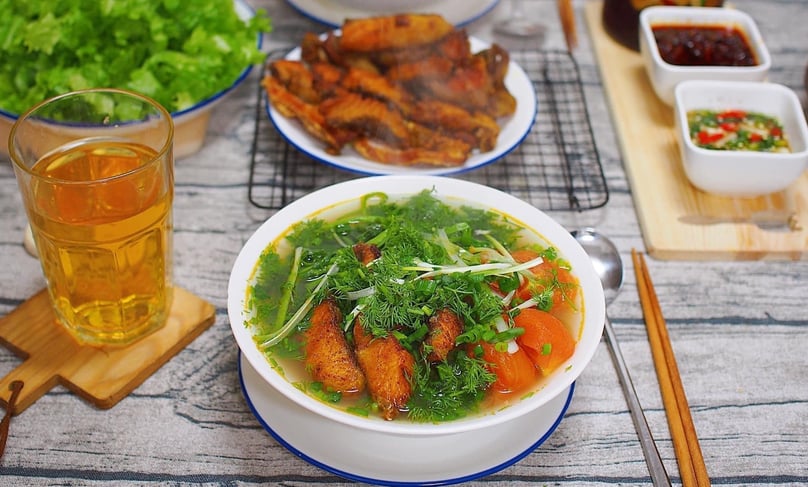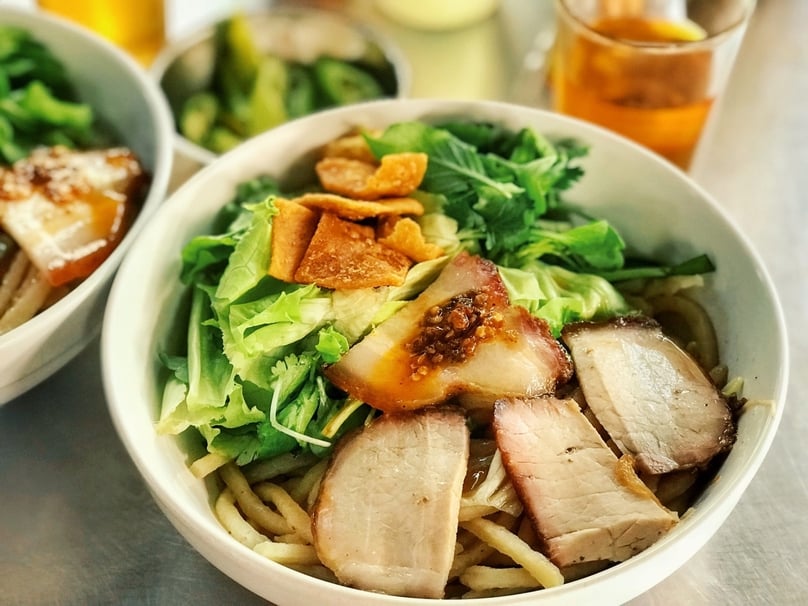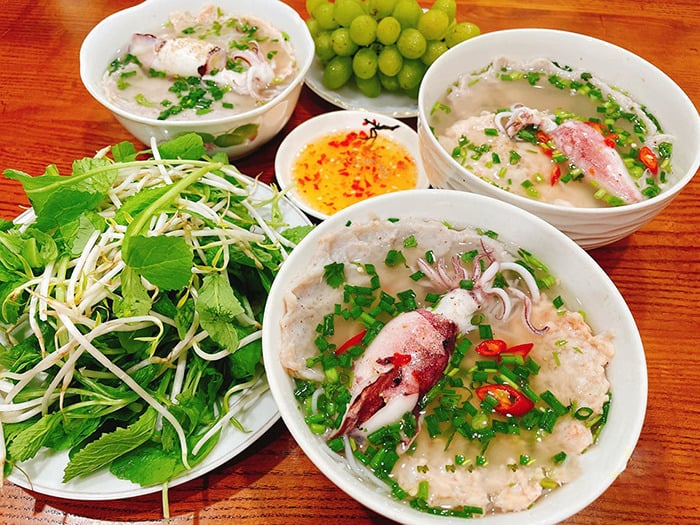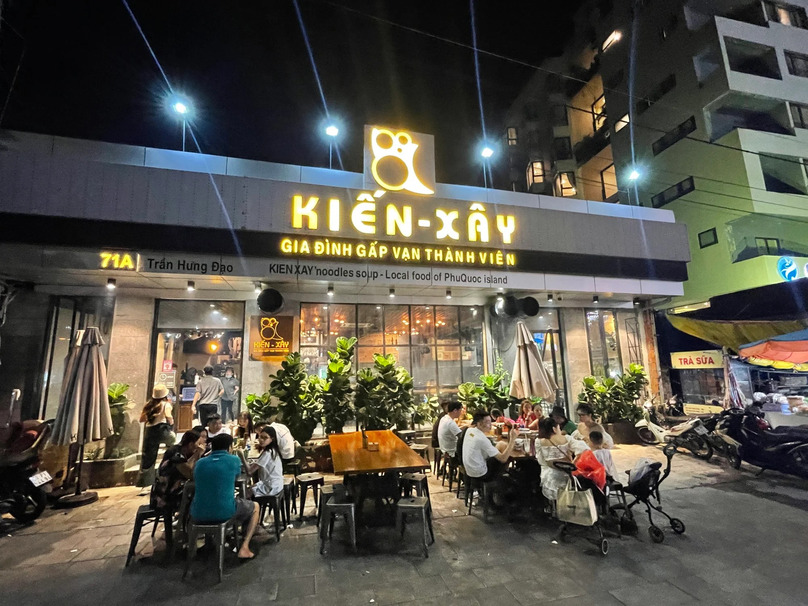Three unmissable Vietnamese noodle dishes: SCMP
Bun ca (rice noodles with fish), cao lau (thick noodles), and bun quay (fresh-cut noodles) are three Vietnamese dishes "not to miss" as voted for by Hong Kong-based daily South China Morning Post.
"While noodle dishes such as pho, bun cha and bun bo Hue are must-eat dishes when visiting Vietnam, it pays to also seek out lesser-known but equally thrilling bowls that are specific to certain towns and cities," SCMP's Chris Dwyer wrote.
Bun ca
Dwyer's noodle journey through Vietnam starts in Hanoi with bun ca, or fish noodle soup, which he described as a "stellar local favourite."
"Like many Vietnamese soups, the deep, sophisticated bun ca broth is made by simmering pork bones for a long time. After this, ingredients are added to the mix including tomatoes, wine vinegar and fresh dill. They impart light and fresh herbal notes and acidity to a dish which beautifully combines sweet and sour."

Bun ca, or fish noodle soup, in Hanoi. Photo courtesy of Netspace.edu.vn.
Toppings can include crunchy fried catfish or bouncy fishcakes, along with mounds of fresh herbs like coriander and basil.
Dwyer suggested among the best bun ca vendors in Hanoi is Bun Ca Huong Thuy, well-known for its generous serving of fish in every bowl, as well as toppings including crunchy taro stems and even fish stomach.
"Despite bun ca’s ubiquity in Hanoi, Vietnamese-American chef Peter Cuong Franklin, chef-patron at the award-winning Ho Chi Minh City restaurant Anan Saigon, prefers a take on the dish found on the coast of southern Vietnam," he wrote.
Dwyer quoted Franklin as saying: "I think the best version of this dish comes from Nha Trang, where it is fully loaded with all the bounty of the sea: a variety of fishcakes, fried fish and fish balls, large chunks of fresh tuna and the wonderful bouncy texture of really fresh jellyfish."
“Bun ngan are noodles with duck in a broth that is aromatic and light, very well-balanced with a clean finish. Then there’s bun oc, noodle soup with snails; a local classic. The broth has an intriguing profile, with intense flavours coming from the Vietnamese herbs, the snails which are poached in it, and a very interesting aftertaste of aniseed," he added.
Cao lau
Dwyer said another worthy noodle destination is Hoi An, the beguiling merchant town that has become one of central Vietnam’s biggest tourist draws thanks to the atmospheric, lantern-filled laneways, waterways, ancient bridges and temples of its well-preserved old town.
"Hoi An’s fantastic cao lau noodles tick all the flavor boxes when it comes to Vietnamese cuisine; they’re sweet, sour, salty, spicy and bitter.
At Quan Cao Lau Thanh, a restaurant in the city, you’d be forgiven for thinking upon first bite that the thick noodles were Japanese udon. The similarity makes sense considering the city’s history," he commented.

Hoi An’s cao lau noodles. Photo courtesy of 2dep.vn.
"What helps make cao lau such a brilliant dish is the layering of all the ingredients: a soup base of slow-simmered pork bones with notes of star anise and cinnamon, five spice pork that has been steeped in soy sauce and fish sauce, a verdant tangle of basil, mint and coriander, and the crunch and freshness of bean sprouts.
"There are also two more final flourishes that complete the dish: a squeeze of calamansi and a generous spoon of smoky, sweet and sticky Hoi An chilli sauce," he commented.
Bun quay
The island of Phu Quoc off Vietnam’s southwest coast is home to bun quay, or fresh-cut noodles, and Kien Xay is one of the area’s most famous purveyors. It started out as a family soup house, but quickly grew in popularity. Today, Kien Xay is a chain with restaurants in Ho Chi Minh City and Hanoi.

Bun quay, or fresh-cut noodles. Photo courtesy of Phu Quoc Travel.
"Bun quay at Kien Xay affords patrons an interactive dining experience because every diner prepares their own nuoc cham dipping sauce. This makes it a popular choice for families," the SCMP writer said.
"First, diners head to a counter under a hanging sign which directs readers, in English, to “make your sauce”. Here you can spoon together your own mix of chilli, fish sauce, calamansi, salt, sugar and MSG, balancing sweet, salty, umami and sour as you see fit."
After this, patrons can watch their rice flour noodles being made. Chefs take a piece of dough and cut it directly into boiling water, before dividing the cooked noodles and broth between bowls, to which are added a slick of shrimp paste and a choice of proteins like shrimp cakes, baby squid or beef.

Bun quay noodles are served at Kien Xay on Phu Quoc Island, southern Vietnam. Photo courtesy of SCMP/Chris Dwyer.
Dwyer shared that a big fan of Kien Xay is Spanish-born Bruno Anon, the executive chef at nearby Regent Phu Quoc hotel, whose love of noodles stems from many years of living in Asia.
“The soft, chewy white rice noodles are perfect with the shrimp, fish paste and simple, clear, slightly sweet broth. The noodles and the seafood are so fresh that all they need to cook is a splash of hot, hearty broth poured over them in the bowl,” Anon was quoted as saying.
“However, really the dipping sauce makes this soup stand out and hits all the taste buds. Its sweet, sour, salty, spicy, and umami," he added.
* Bun Ca Huong Thuy, 14 Nguyen Trung Truc street, Ba Dinh district, Hanoi.
* Quan Cao Lau Thanh, 6 Thai Phien street, Minh An district, Hoi An town, Quang Nam province.
* Kien Xay, 28 Bach Dang Road, Duong Dong district, Phu Quoc island, Kien Giang province.
- Read More
Maersk eyes building major container ports in Vietnam
A.P.Moller - Maersk (Maersk) is exploring investment opportunities to develop large, modern and low-carbon container ports in Vietnam.
Infrastructure - Wed, November 19, 2025 | 4:36 pm GMT+7
Taiwan semiconductor giant Panjit acquires 95% of Japan-based Torex’s Vietnam arm
Panjit International Inc, a Taiwan-listed semiconductor major, has approved the acquisition of a 95% stake in Torex Vietnam Semiconductor, a subsidiary of Japan-based Torex.
Companies - Wed, November 19, 2025 | 3:59 pm GMT+7
Vietnam PM urges Kuwait Petroleum to expand Nghi Son refinery, build bonded fuel storage facility
Prime Minister Pham Minh Chinh on Tuesday called on Kuwait Petroleum Corporation (KPC) to expand the Nghi Son oil refinery and build a bonded fuel storage facility in Vietnam.
Industries - Wed, November 19, 2025 | 3:18 pm GMT+7
Southern Vietnam port establishes strategic partnership with Japan’s Port of Kobe
Long An International Port in Vietnam’s southern province of Tay Ninh and Japan’s Port of Kobe on Monday signed an MoU establishing a strategic port partnership which is expected to boost trade flows, cut logistics costs, and deliver greater benefits to businesses across the region.
Companies - Wed, November 19, 2025 | 10:14 am GMT+7
Thaco's agri arm seeks to expand $44 mln cattle project in central Vietnam
Truong Hai Agriculture JSC (Thaco Agri), the agriculture arm of conglomerate Thaco, looks to aggressively expand its flagship cattle farming project in the central Vietnam province of Gia Lai.
Industries - Wed, November 19, 2025 | 9:56 am GMT+7
Japan food major Acecook eyes new plant in southern Vietnam
Acecook, a leading instant noodle maker with 13 plants operating in Vietnam, is studying a new project in the southern province of Tay Ninh.
Industries - Wed, November 19, 2025 | 9:39 am GMT+7
Vietnam’s largest Aeon Mall to take shape in Dong Nai province
Authorities of Dong Nai province, a manufacturing hub in southern Vietnam, on Monday awarded an investment registration certificate to Japanese-invested Aeon Mall Vietnam Co., Ltd. for its Aeon Mall Bien Hoa project.
Industries - Tue, November 18, 2025 | 8:17 pm GMT+7
Police propose prosecuting Egroup CEO Nguyen Ngoc Thuy for fraud, bribery
Vietnam’s Ministry of Public Security has proposed prosecuting Nguyen Ngoc Thuy, chairman and CEO of Hanoi-based education group Egroup, along with 28 others, for fraud to appropriate property, giving bribes, and receiving bribes.
Society - Tue, November 18, 2025 | 4:01 pm GMT+7
Singapore-backed VSIP eyes large urban-industrial complex in southern Vietnam
A consortium involving VSIP, a joint venture between local developer Becamex IDC and Singapore’s Sembcorp, plans a large-scale urban-industrial development named the "Moc Bai Xuyen A complex along the Tay Ninh-Binh Duong economic corridor in southern Vietnam.
Industrial real estate - Tue, November 18, 2025 | 2:38 pm GMT+7
Aircraft maintenance giant Haeco to set up $360 mln complex in northern Vietnam
Hong Kong-based Haeco Group, Vietnam's Sun Group, and some other partners plan to invest $360 million in an aircraft maintenance, repair and overhaul (MRO) complex at Van Don International Airport in Quang Ninh province - home to UNESCO-recognized natural heritage site Ha Long Bay.
Industries - Tue, November 18, 2025 | 2:13 pm GMT+7
Thai firm opens 20,000-sqm shopping center in central Vietnam hub
MM Mega Market Vietnam (MMVN), a subsidiary of Thailand's TCC Group, on Monday opened its MM Supercenter Danang, a 20,000 sqm commercial complex with total investment capital of $20 million, in Danang city.
Real Estate - Tue, November 18, 2025 | 12:20 pm GMT+7
Vietnam PM asks Kuwait fund to expand investment in manufacturing, logistics, renewable energy
Prime Minister Pham Minh Chinh on Monday called on the Kuwait Fund for Arab Economic Development (KFAED) to strengthen cooperation with Vietnam, particularly in the areas of industrial production, logistics, renewable energy, green economy, and the Halal ecosystem.
Economy - Tue, November 18, 2025 | 11:53 am GMT+7
Thai dairy brand Betagen to build first plant in Vietnam
Betagen, a famous Thai dairy brand, plans to build its first manufacturing plant in Vietnam, located in the southern province of Dong Nai.
Industries - Tue, November 18, 2025 | 8:49 am GMT+7
Banks dominate Vietnam's Q3 earnings season, Novaland posts biggest loss
Banks accounted for more than half of the 20 most profitable listed companies in Vietnam’s Q3/2025 earnings season, while property developer Novaland recorded the largest loss.
Finance - Tue, November 18, 2025 | 8:24 am GMT+7
Highlands Coffee posts strongest quarterly earnings in 2 years on robust same-store sales
Highlands Coffee, Vietnam’s largest coffee chain, delivered its best quarterly performance in two years, with Q3 EBITDA exceeding PHP666 million ($11.27 million), parent company Jollibee Foods Corporation (JFC) said in its latest earnings report.
Companies - Mon, November 17, 2025 | 10:21 pm GMT+7
Hong Kong firm Dynamic Invest Group acquires 5% stake in Vingroup-backed VinEnergo
VinEnergo, an energy company backed by Vingroup chairman Pham Nhat Vuong, has added a new foreign shareholder after Hong Kong–based Dynamic Invest Group Ltd. acquired a 5% stake, according to a regulatory filing on Saturday.
Companies - Mon, November 17, 2025 | 9:52 pm GMT+7
























